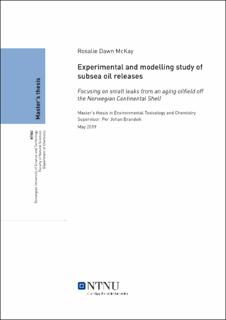| dc.description.abstract | With advances in exploration and extraction technology, oilfields that would otherwise have been ready for decommission are expected to produce oil for many more years. While beneficial to extract as much resource as possible from existing fields, this prolonged usage also increases the potential for oil leaks from aging pipelines. These pipeline leaks can produce high velocity conditions that emit plumes of small droplets of oil, gas and produced water. This is in contrast to large diameter blowouts where much larger droplets are expected. The exit parameters and resulting size distribution of oil droplets have a significant impact on the fate of oil in the environment.
Using the SINTEF MiniTower in conjunction with a silhouette camera, the droplet size distributions for discharge conditions representative of small diameter, high velocity leaks of oil and produced water were obtained. These distributions were then used to empirically optimize the coefficients, A 8.5 and B 7.68, for use in droplet size prediction with the Modified Weber algorithm. These optimized coefficients predicted larger droplet sizes than the previously reported values, for small diameter, high velocity releases. A series of pipeline leaks and blowouts operating under different seasonal and release conditions were generated with the SINTEF oil spill modelling simulation tool, OSCAR. The Njord field was selected as a proxy for mature oilfields along the Norwegian Continental Shelf. The releases modelled produced thin and spread out surface slicks, which limited the effectiveness of response methods. The low surface oil thickness limited shoreline oiling, and the formation of tarballs would not be expected. This makes the Njord field an unlikely candidate source for oil pollution samples collected in the Frøya municipality region during an excursion in 2017. This fieldwork was carried out as part of the course Marine Organic Environmental Chemistry KJ3050 as a requisite of the Environmental Toxicology and Chemistry Master program at NTNU. Experimental and modelling studies are necessary to ensure appropriate monitoring and contingency planning for maturing oilfields. | |
